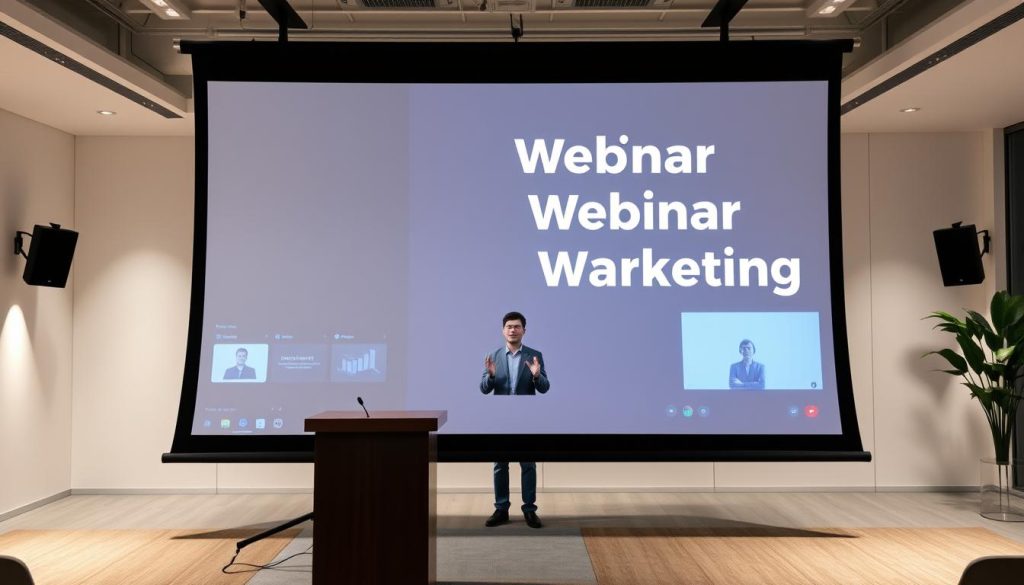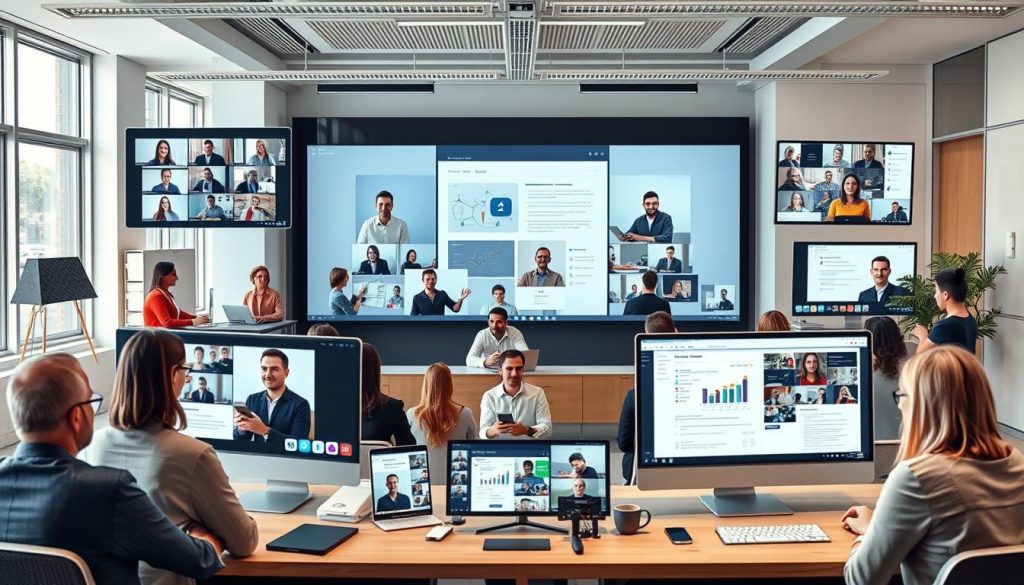We continue to see webinars as a major generator of leads across every stage of the marketing funnel. People are logging on to webinars, whether live or on-demand, indicating a persistent interest in virtual events.
To drive growth and transform your business, leveraging expert webinar marketing ideas is crucial. With the rise of digital marketing, webinars have become an essential tool for lead generation and customer engagement.
By implementing effective strategies and best practices for hosting successful webinars, businesses can experience significant growth.
Key Takeaways
- Leverage webinars for lead generation across the marketing funnel.
- Utilize virtual event promotion to boost attendance.
- Implement expert webinar marketing ideas to drive business growth.
- Focus on creating engaging content for your webinars.
- Optimize your webinar strategy for maximum ROI.
Understanding Webinar Marketing
Webinar marketing has emerged as a pivotal strategy for businesses aiming to expand their reach and engage with their audience more effectively. At its core, webinar marketing involves using online seminars or workshops to achieve specific marketing goals.

What is Webinar Marketing?
Webinar marketing is a digital marketing strategy that utilizes webinars as a tool to promote products, services, or ideas to a targeted audience. A webinar is any online event where a speaker, or group of speakers, delivers a presentation to a receptive audience. This one-to-many marketing tactic allows businesses to contextualize their brand messaging and products, providing value to potential customers.
By leveraging online seminar strategies, businesses can create engaging, interactive experiences that foster a deeper connection with their audience. Webinar marketing is not just about presenting information; it’s about creating a meaningful dialogue with potential customers.
Benefits of Hosting Webinars
Hosting webinars offers numerous benefits, including increased brand awareness, lead generation, and enhanced customer engagement. Webinars provide a platform for businesses to showcase their expertise, build trust with their audience, and demonstrate the value of their products or services.
- Generate high-quality leads through targeted content
- Establish thought leadership in your industry
- Enhance customer engagement through interactive sessions
- Increase brand visibility and reach a wider audience
By incorporating digital workshop tips into their webinar marketing strategy, businesses can optimize their webinars for maximum impact, ensuring that their message resonates with the target audience.
Common Misconceptions
Despite its potential, webinar marketing is often misunderstood. One common misconception is that webinars are too time-consuming or costly to produce. However, with the right strategy and tools, businesses can create effective webinars that drive results without excessive investment.
Another misconception is that webinars are only suitable for certain industries or business models. In reality, webinar marketing can be adapted to suit a wide range of businesses, from B2B to B2C, and across various sectors.
By understanding the true potential of webinar marketing and dispelling common misconceptions, businesses can harness the power of webinars to achieve their marketing goals.
Defining Your Target Audience
Understanding your target audience is the cornerstone of a successful webinar marketing strategy. Knowing who your audience is will help you customize and optimize every webinar experience for better results.
Identifying Audience Needs
To effectively identify your audience’s needs, you must first understand their pain points and interests. This involves researching their challenges and what they hope to achieve through your webinar. Effective webinar planning techniques involve creating content that resonates with your audience’s needs.
- Conduct surveys or polls to understand audience expectations.
- Analyze feedback from previous webinars or events.
- Research industry trends to stay relevant.
Segmenting Your Market
Segmenting your market allows you to tailor your webinar content to specific groups within your audience. This can be based on demographics, interests, or stages of the buying journey. By doing so, you can apply virtual conference best practices to create a more personalized experience.
- Identify key demographics that are relevant to your webinar topic.
- Create content that speaks to the specific needs of each segment.
- Use targeted marketing efforts to reach each segment effectively.
Crafting Buyer Personas
Crafting detailed buyer personas is essential for understanding your ideal webinar attendees. These personas should include demographic information, goals, challenges, and behavioral patterns. Persona development is a critical step in creating a webinar that resonates with your target audience.
- Develop semi-fictional characters based on your research.
- Use these personas to guide your content creation and marketing strategies.
- Continuously update your personas based on new data and feedback.
By following these steps, you can ensure that your webinar is tailored to the needs and interests of your target audience, ultimately leading to a more successful and engaging virtual conference experience.
Choosing the Right Webinar Topic
To boost webinar engagement, it’s essential to pick a topic that is both relevant and timely. The success of your webinar hinges on how well your topic resonates with your target audience. We will explore how to align your webinar topic with audience interests, evaluate industry trends, and conduct surveys to ensure your topic is engaging.
Aligning with Audience Interests
Understanding your audience’s needs and interests is paramount. By aligning your webinar topic with these interests, you can significantly enhance engagement. For instance, if your audience is interested in learning about the latest live stream marketing ideas, crafting your topic around this theme can be highly effective.
To achieve this alignment, consider the following strategies:
- Review feedback from previous webinars or events
- Analyze industry-related content that has garnered significant engagement
- Engage with your audience through social media to understand their current concerns and interests
Evaluating Industry Trends
Staying abreast of industry trends is crucial for selecting a relevant webinar topic. By evaluating what’s currently trending, you can identify opportunities to create timely and engaging content. For example, if there’s a surge in interest in a particular technology or methodology, you can tailor your webinar to address this interest.
Some ways to evaluate industry trends include:
- Monitoring industry news and updates
- Attending conferences and seminars
- Using tools like Google Trends to identify popular topics
For more insights on choosing a webinar topic, you can refer to our detailed guide on tips for choosing the right webinar.
Conducting Audience Surveys
Directly engaging with your audience through surveys can provide valuable insights into their preferences and interests. By asking the right questions, you can gather data that will help you craft a webinar topic that is both relevant and appealing.
Consider the following when conducting audience surveys:
| Survey Questions | Purpose | Expected Outcome |
|---|---|---|
| What topics are you most interested in learning about? | Identify audience interests | List of preferred topics |
| What challenges are you currently facing? | Understand audience needs | Insights into audience pain points |
| How do you prefer to engage with webinar content? | Determine engagement preferences | Preferred formats for webinar content |
By following these steps and incorporating webinar engagement tactics, you can create a compelling webinar that resonates with your audience.

Selecting the Right Webinar Format
The webinar format you choose can significantly impact the success of your virtual event. With various options available, it’s essential to select the one that best aligns with your goals and audience preferences.

Live vs. Recorded Webinars
One of the primary decisions you’ll need to make is whether to host a live or recorded webinar. Live webinars offer real-time interaction with your audience, allowing for immediate Q&A sessions and a more dynamic experience. On the other hand, recorded webinars provide flexibility for viewers who may not be able to attend at the scheduled time, and they can be repurposed for future marketing efforts.
As noted by industry expert, “Live webinars create a sense of urgency and can lead to higher engagement rates.” However, recorded webinars offer the advantage of being able to reach a wider audience over time.
Panel Discussions and Q&A Sessions
Incorporating panel discussions and Q&A sessions can significantly enhance the engagement level of your webinar. Panel discussions bring together multiple experts, offering a variety of perspectives on the topic at hand. Q&A sessions, whether conducted live or through a moderated chat, allow attendees to interact with the speakers, clarifying any doubts they may have.
- Panel discussions foster a richer understanding of complex topics.
- Q&A sessions provide an opportunity for attendees to engage directly with the speakers.
- Both formats can be adapted to either live or recorded webinars.
Interactive Webinars
Interactive webinars are designed to keep the audience engaged through various interactive elements such as polls, quizzes, and live chats. These features not only make the webinar more enjoyable but also provide valuable feedback for the hosts.
“Interactive elements are crucial for maintaining audience engagement during webinars.” – Webinar Expert
By incorporating these interactive elements, you can create a more immersive experience for your attendees, increasing the likelihood of achieving your webinar goals.
Crafting Compelling Content
Compelling content is the backbone of any successful webinar, driving audience engagement and conversion. To achieve this, we need to focus on several key elements that make our content engaging, informative, and memorable.
Developing an Engaging Script
An engaging script is the foundation of a successful webinar. We recommend starting with a clear outline of the topics you want to cover, ensuring they align with your webinar marketing ideas and the interests of your target audience. Your script should be concise, informative, and free of jargon that might confuse your audience.
To make your script more engaging, incorporate storytelling techniques and real-life examples that illustrate your points. Practice your delivery to ensure you come across as confident and knowledgeable.
Utilizing Visual Aids
Visual aids such as slides, videos, and infographics can significantly enhance the engagement level of your webinar. They help to illustrate complex concepts, making them easier to understand. When designing your visual aids, keep them simple, clear, and relevant to your content.

Ensure that your visual aids are consistent in design and formatting, reinforcing your brand identity. Use them sparingly to avoid overwhelming your audience.
Incorporating Storytelling Techniques
Storytelling is a powerful tool in webinar marketing, allowing you to connect with your audience on an emotional level. By sharing relevant stories, you can make your content more relatable and memorable. Use narratives to illustrate key points, making your message more impactful.
To effectively incorporate storytelling, identify the core message you want to convey and craft a story around it. Use vivid language and descriptive details to bring your story to life, engaging your audience and making your content more compelling.
Promoting Your Webinar Effectively
A well-planned promotional strategy can significantly boost webinar attendance. To achieve this, we need to leverage multiple channels and tactics to reach our target audience effectively.
Leveraging Email Marketing
Email marketing remains one of the most effective ways to promote webinars. Building an email list of potential attendees is crucial. We can achieve this by creating sign-up forms on our website and offering incentives such as free e-books or exclusive content.
Once we have a list, we can craft compelling email campaigns that highlight the benefits of attending our webinar. Personalization is key here; addressing recipients by name and tailoring the content based on their interests can significantly improve engagement.
| Email Marketing Strategy | Description | Benefits |
|---|---|---|
| Personalized Emails | Tailoring email content to individual interests | Increased engagement, higher open rates |
| Reminder Emails | Sending reminders as the webinar date approaches | Improved attendance rates |
| Follow-up Emails | Sending emails after the webinar to thank attendees and provide additional resources | Enhanced attendee experience, potential for further engagement |
Social Media Promotion Strategies
Social media platforms offer a vast opportunity to promote our webinar. We can create engaging content such as teaser videos and infographics to capture attention.
Utilizing paid social media ads can also help us reach a broader audience. Platforms like LinkedIn and Facebook allow for precise targeting based on demographics, interests, and behaviors.

Collaborating with Influencers
Partnering with influencers in our industry can amplify our webinar’s reach. We should identify influencers who align with our webinar topic and have a following that matches our target audience.
Collaborations can take many forms, from guest blog posts to social media shoutouts. Choosing the right influencers and crafting a mutually beneficial partnership is essential for maximizing the impact of our promotional efforts.
Engaging Your Audience During the Webinar
Keeping your audience engaged is vital for a webinar’s success, and we will explore how to do this effectively. Engaging your audience involves a combination of strategies that foster interaction, encourage participation, and build a sense of community.
Strategies for Interaction
To keep your audience engaged, it’s crucial to incorporate various webinar engagement tactics. One effective way is to use interactive elements such as live chats, where attendees can ask questions and receive immediate responses. We also recommend using gamification elements, like rewards or challenges, to make the experience more engaging.
As noted by experts, “Interactive content is key to maintaining audience interest.”
“The most successful webinars are those that engage attendees through meaningful interactions.”
This can be achieved througheffective webinar engagement strategies, which not only boost participation but also enhance the overall experience.
Utilizing Polls and Q&As
Polls and Q&A sessions are powerful tools for increasing audience engagement. By conducting live polls, you can gather feedback and encourage attendees to participate actively. Q&A sessions, on the other hand, provide an opportunity for attendees to clarify their doubts and engage in meaningful discussions.

To maximize the effectiveness of polls and Q&As, consider the following live stream marketing ideas:
- Keep polls concise and relevant to the topic.
- Encourage attendees to ask questions throughout the webinar.
- Address questions promptly to maintain audience interest.
Encouraging Networking Opportunities
Networking is a vital aspect of webinars, as it allows attendees to connect with each other and build meaningful relationships. To facilitate this, consider incorporating networking sessions or breakout rooms where attendees can discuss topics of interest.
By providing opportunities for networking, you can create a more engaging and interactive experience for your audience. As we continue to explore webinar engagement tactics, it’s clear that fostering a sense of community is essential for a successful webinar.
Following Up After Your Webinar
Following up after your webinar is a critical step in converting interest into action. It’s the phase where you nurture the leads generated and lay the groundwork for future webinars. Effective follow-up strategies can significantly enhance the overall success of your virtual event success strategies.
Sending Thank You Emails
Sending thank you emails is more than a courtesy; it’s an opportunity to further engage your audience. We recommend personalizing these emails by addressing attendees by name and referencing specific topics discussed during the webinar. This personal touch can make a significant difference in how your follow-up is received.
Here’s an example of how to structure your thank you email:
- Subject Line: Thank you for joining us!
- Introduction: Acknowledge their attendance and express gratitude.
- Body: Provide additional resources or next steps.
- Call-to-Action (CTA): Encourage further engagement, such as signing up for a future webinar or downloading a related resource.
Sharing Recorded Sessions
Sharing recorded sessions of your webinar can extend its reach beyond the live audience. We suggest sharing these recordings through email, social media, and your website. This not only provides value to those who attended but also attracts new viewers who may have missed the live event.
To maximize the impact, consider the following strategies:
| Platform | Strategy | Benefit |
|---|---|---|
| Send a follow-up email with the recording link. | Directly engages attendees and provides additional value. | |
| Social Media | Share snippets or teasers of the webinar. | Increases visibility and attracts new viewers. |
| Website | Host the recording on a dedicated webinar page. | Enhances your website’s content and attracts organic traffic. |
Gathering Audience Feedback
Gathering audience feedback is crucial for understanding the strengths and weaknesses of your webinar. We use surveys or feedback forms to collect insights from attendees. This information is invaluable for refining your online seminar strategies and improving future webinars.
When gathering feedback, consider asking questions such as:
- What did you find most valuable about the webinar?
- Were there any topics you felt were not adequately covered?
- How likely are you to attend another webinar on a similar topic?
By following these steps and incorporating feedback into your planning, you can continually enhance your webinar strategy and achieve greater success.
Measuring Webinar Success
Understanding how to measure webinar success is key to enhancing your overall marketing strategy. To do this effectively, we need to track the right metrics, analyze audience engagement, and adjust our strategies based on the feedback received.
Key Metrics to Track
To evaluate the success of your webinar, we must focus on key performance indicators (KPIs) that provide insights into its impact. Some of the crucial KPIs include:
- Registration numbers and attendance rates
- Engagement metrics such as poll responses and Q&A participation
- Conversion rates, including sales or lead generation
By monitoring these metrics, we can gain a comprehensive understanding of our webinar’s performance.
| KPI | Description | Importance |
|---|---|---|
| Registration Numbers | Total number of registrations | Indicates initial interest |
| Attendance Rate | Percentage of registrants who attended | Shows actual engagement |
| Conversion Rate | Percentage of attendees who converted (e.g., made a purchase) | Measures the webinar’s effectiveness |
Analyzing Audience Engagement
Analyzing audience engagement is crucial for understanding how well your webinar content resonated with attendees. We look at metrics such as:
- Average viewing time and drop-off points
- Participation in polls and Q&A sessions
- Feedback from surveys conducted during or after the webinar
By examining these engagement metrics, we can identify areas of strength and weakness in our webinar content.
Adjusting Strategies Based on Feedback
The final step in measuring webinar success is to adjust our strategies based on the feedback and data collected. This involves:
- Refining our content to better meet audience needs
- Improving our promotion strategies to increase registration and attendance
- Enhancing engagement through more interactive elements or better timing
By continuously refining our approach based on webinar performance data, we can improve future webinars and maximize their impact.
Scaling Webinar Efforts for Future Growth
To maximize the impact of your webinars, it’s essential to scale your efforts for future growth. This involves implementing strategies that streamline your process, enhance engagement, and drive long-term success.
Creating a Cohesive Webinar Series
Building a webinar series allows you to explore topics in-depth, establishing your brand as a thought leader in the industry. By doing so, you can foster a loyal audience and create opportunities for virtual event promotion.
Maximizing Content Value
Repurposing webinar content is a valuable strategy for extending its lifespan. This can include transforming webinar recordings into blog posts, social media content, or even eBooks, thereby maximizing your investment in webinar planning techniques.
Streamlining with Automation
Leveraging automation tools is crucial for efficient webinar management. These tools enable you to automate tasks such as email reminders, follow-up emails, and registration processes, allowing you to focus on creating high-quality content and promoting your webinars effectively.
